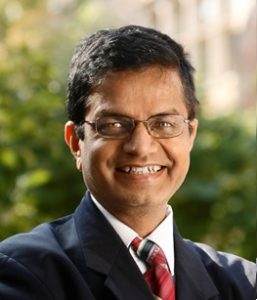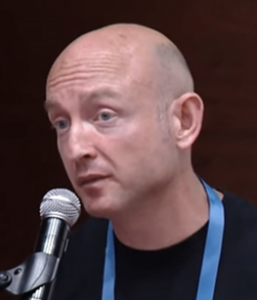Tuesday, June 26, 2018
9:15 a.m. – 10:00 a.m
Room: Cartier
Keynote #1: Trends and Issues in Softwarization of Networks
Raj Jain
Abstract: We begin with developments that led to virtualization, network function virtualization, and disaggregation. How software-defined networking definition has changed due to disaggregation. The trend of DevOps and the slowness of the standardization activities has led the networking industry towards open source software and hardware. Open sourcing has now become the fastest way to introduce new research, idea, concept or technology. All these trends and their impact on networking research along several related myths and issues will be discussed in this talk.
Bio: Raj Jain is the Barbara J. and Jerome R. Cox, Jr., Professor of Computer Science and Engineering at Washington University in St. Louis. Previously, he was one of the Cofounders of Nayna Networks, Inc – a next-generation telecommunications systems company in San Jose, CA. Dr. Jain has a Ph.D. in applied mathematics and computer science from Harvard University. He is a Fellow of IEEE, ACM, AAAS, and Academy of Science St. Louis. He is the recipient of 2017 ACM SIGCOMM award, 2015 A. A. Michelson Award from Computer Measurement Group and numerous other awards. With 27,000+ citations according to Google Scholar, he is one of the most cited authors in computer science. Further information is at http://www.cse.wustl.edu/~jain/
Wednesday, June 27, 2018
9:15 a.m. – 10:00 a.m.
Room: Cartier
Keynote #2: SDX (Software-Defined Everything) 2.0
Jeff Tantsura
Abstract: With the proliferation of hybrid cloud, massive increase in the number of end-points, from IoT devices to containers and majority of the data moving within data centers, the need for a coherent, end to end programmatic approach has become a hard necessity.
In order for businesses to successfully continue on the path to digital transformation, requirement for more advanced functionality have been arising.
Functionality provided by the first wave of SDN solutions has been instrumental to move into the right direction however not enough to address businesses needs in the fast-paced environment.
SDX 1.0 has been focusing on the basic networking needs, separated in silos:
- SD-WAN: basic connectivity, cheaper and faster alternative to MPLS VPNs
- SD-Cloud: configuration and operation automation, homogenous environments
- SD-Security: basic segmentation, distributed FW, moving away from diameter security to end points
SDX 2.0 is a cooperative, policy driven approach, the opposite to SDX 1.0 silos structure, with end to end security as the foundation:
- Analytical-driven, location independent application connectivity
- Hybrid and heterogeneous environments, data-driven automation, edge computing Data Center
- Application context based micro-segmentation, analytical-driven insights security
Bio: Jeff Tantsura has been in the networking space for 20+ years. He has authored and contributed to many RFC’s and patents and worked in both SP and vendor environments. Currently he is Nuage Networks’ Head of Technology Strategy, overviewing the complete SDX(SD-WAN, SD-Security and SD-Cloud) portfolio. He is also co-chair of the IETF Routing Working Group, chartered to work on New Network Architectures and Technologies, including protocol independent YANG models and Next Gen Routing Protocols, as well as co-chair of the RIFT (Routing in Fat Trees) Working Group, chartered to work on a new routing protocol that specifically addresses Fat Tree topologies typically seen in the Data Center environment. In addition, Jeff serves on the Internet Architecture Board (IAB). His focus has been 5G transport and integration with RAN, IoT, MEC, Low Latency, and Data modeling.
Thursday, June 28, 2018
8:30 a.m. – 9:15 a.m.
Room: Cartier
Keynote #3: Network Transformation @ Bell
Nicholas Payant
Abstract: Communications service providers around the world continue to see accelerating traffic and device growth as well as new end-user applications driving different service quality requirements on their networks. Coupled with next generation technology introductions such as 5G, SDN, NFV, Big Data, IoT, open source platforms and others, the complexity challenge demands a fundamental transformation in how service providers engineer, build and manage their legacy, current and next generation networks. This presentation will outline Bell Canada’s strategies on how to leverage software, automation, and process transformation to tackle the complexity challenge while delivering the Best Network for our customers.
Bio: Nicholas Payant, Vice-President, Infrastructure and Connectivity, is accountable for the development, planning, engineering, deployment and operation of the Core Network connectivity, including internet, MPLS, residential gateways and network data center infrastructure to enable all of Bell’s services to run seamlessly for our customers. Prior to this role, Nick served as Director, Network Operations where he was responsible operating and maintaining Bell Canada’s wireline core network (24/7), with focus on the surveillance, repair & maintenance of Bell’s broadband, access, IP Core and Transport. Since joining the Bell team in 2000,Nick also held several technology and engineering positions within wireless, where he led or participated in major technology evolution projects including CDMA, EVDO, HSPA overbuild, and LTE
Thursday, June 28, 2018
9:15 a.m. – 10:00 a.m
Room: Cartier
Keynote #4: A New Way to Evolve the Internet
Richard Li
Abstract: Recent years have brought the current Internet design to the limits of what it can support. New services such as Industrial Internet, Tactile Internet, Vehicular Networks, and networked AR/VR delivery with their requirements for deterministic service-level guarantees or ultra-low latency have brought current networks to their breaking point. Custom solutions explode in complexity and result in massive tradeoffs in terms of overall network efficiency. A rethinking of current Internet principles is needed in order to meet tomorrow’s challenges of novel applications that provide immersive experiences and that pose unprecedented requirements in terms of high precision, seamless mobility, and intrinsic security. It is time to lay out new internetworking principles. This talk identifies those new principles and outlines a new networking approach, Big Packet Protocols, whose features include a novel network programming model that promises to unleash innovation that will power the next wave of future networking applications.
Bio: Dr. Renwei Li (Richard Li) works as Chief Scientist and Vice-President of Future Networks, Huawei USA. His main interests include, but not limited to, network architectures, technologies, protocols, solutions, and software for future applications such as industrial digitalization, vehicular networks, industrial internet, tactile networks, networked AR/VR, and many others promised and enabled by 5G. Richard also serves as Vice Chair of ETSI NGP, an industrial specification group on next-generation protocols within European Telecommunications Standards Institute (ETSI). In the past with Huawei, Richard worked as Chief Architect and Vice-President of the Internet Technology Lab of Huawei USA and spearheaded the technology invention and software development in the area of Routing and MPLS, Cloud and Virtualization, SDN, and Orchestration. Prior to joining Huawei, Richard worked with Cisco and Ericsson, being a major contributor to their networking technologies, standards, solutions and operating systems. Richard received his PhD degree in Mathematics with specialization in AI and Computer Science from Instituto Superior Técnico, Universidade de Lisboa. He has also studied or worked in Simon Fraser University, Universidade Nova de Lisboa, and Chinese Academy of Sciences, respectively.











